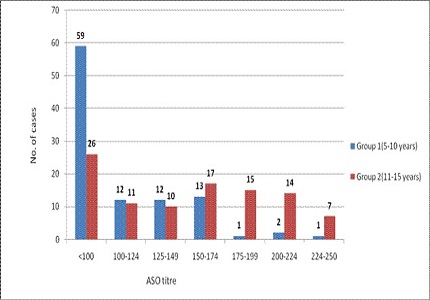Anti streptolysin O (ASO) titers in normal healthy children aged between 5 to 15 years in Ujjain region
Abstract
Introduction: Rheumatic fever is an inflammatory disease that may develop after an infection with Streptococcus pyogenes bacteria, believed to be caused by antibody cross reactivity that can involve heart, joints, skin and brain. Measurement of Anti Streptolysin O (ASO) antibodies to specific streptococcal antigens is therefore necessary for the diagnosis of the preceding Group A Streptococcal (GAS) infection.
Aims and objectives: To determine the upper limit of the normal ASO titers in normal healthy school going children aged 5-15 years and to determined a baseline value to compare with when a single ASO titer is available.
Material and method: A community based cross sectional study was done on normal healthy children aged 5-15 years divided into group 1 (5-10 years) and group 2 (11-15 years) after taking informed consent from parents. Blood sample were collected after thorough sterilization of the area. ASO testing from serum sample was done using TURBILYTE Antistreptolysin ‘O’ diagnostic reagent for quantitative in-vitro determination of ASO in serum on photometric systems.
Results: Out of total 200 children included in the study, 100 were in group 1 and 100 in group 2, 118 (59 %) were males and 82 (41 %) were females. The mean ASO titer for group 1 was 105.69 IU and that of group 2 was 144.73 IU with a standard deviation of 3.675 and 5.823 respectively (P value <0.05). Out of total 200 students 160 were living in overcrowded conditions. The mean ASO titer of children with overcrowded living conditions was 131.41 IU with a standard deviation of 53.472, and those with non-overcrowded living condition was 100.42 IU with a standard deviation of 39.30 (P value < 0.05).
Conclusion: The upper limit of normal (ULN) was greater in the children of Group 1 (P value <0.05, 200 Vs 135). No statistically significant difference was found in the ASO titer according to gender. Statistically significant high mean ASO titer (131.41 IU) was found in children living in overcrowded conditions as compared to those living under non-overcrowded conditions (100.41 IU).
Downloads
References
2. Lennon D. Acute Rheumatic Fever. In: Feigin R and Cherry J (Eds), Textbook of Pediatric Infectious Diseases, 5th ed. Philadelphia: WB Saunders; 2004:413-26.
3. Carapetis JR. A review of WHO activities. In: The Burden of and the Evidence for Strategies to Control Group A Streptococcal Diseases: Part 3: The Current Evidence for the Burden of Group A Streptococcal Diseases. Geneva: World Health Organization; 2004:1-49.
4. Sethi S, Kaushik K, Mohandas K, Sengupta C, Singh S, Sharma M. Anti-streptolysin O titers in normal healthy children of 5-15 years. Indian Pediatr. 2003 Nov;40(11):1068-71. [PubMed]
5. Stollerman GH. Rheumatic fever. Lancet. 1997 Mar 29;349(9056):935-42. [PubMed]
6. Kaplan EL, Ferrieri P, Wannamaker LW. Comparison of the antibody response to streptococcal cellular and extracellular antigens in acute pharyngitis. J Pediatr. 1974 Jan;84(1):21-8.
7. Mahendrappa Kotyal B, Rajendra. Upper Limit of Normal Antistreptolysin-O Titer in Healthy School Children. Indian Pediatr. 2010 July; 47(7): 629.
8. Shogo Otsuji, TetsuroKamada, Tsuneaki Matsuura, Masashi Seki, Kiko Tanaka, Hideaki Shibata and Tetsuro Honda. A rapid turbidimetric immunoassay for serum antistreptolysin-O2. Journal of Clinical Laboratory Analysis.2005: 241-245. DOI: 10. 1002/jcla.1860040402.
9. WANNAMAKER LW, AYOUB EM. Antibody titers in acute rheumatic fever. Circulation. 1960 Apr;21:598-614. [PubMed]
10. Danchin MH, Carlin JB, Devenish W, Nolan TM, Carapetis JR. New normal ranges of antistreptolysin O and antideoxyribonuclease B titres for Australian children. J Paediatr Child Health. 2005 Nov;41(11):583-6.
11. MG Karmarkar, Vineetha Venugopal, Leela Joshi & Riecha Kamboj. Evaluation and revaluation of upper limits of normal values of anti- Streptolysin O and anti deoxyribonucleasse B in Mumbai. Indian J Med Res. 2004;119:26-28.

Copyright (c) 2017 Author (s). Published by Siddharth Health Research and Social Welfare Society

This work is licensed under a Creative Commons Attribution 4.0 International License.


 OAI - Open Archives Initiative
OAI - Open Archives Initiative


